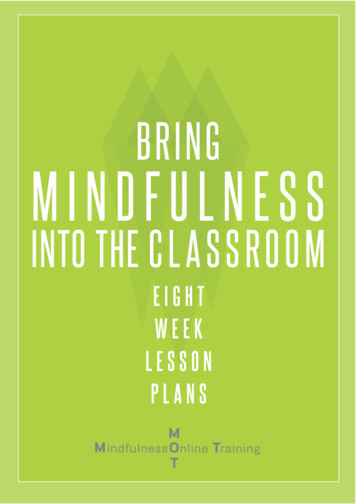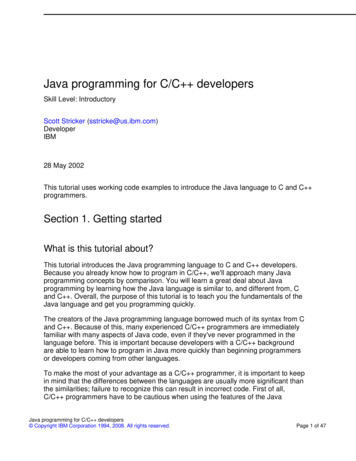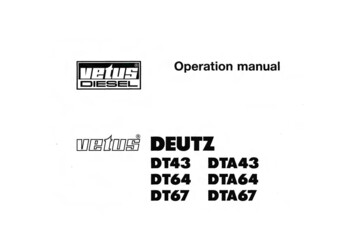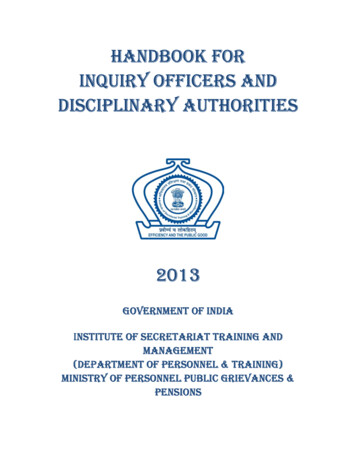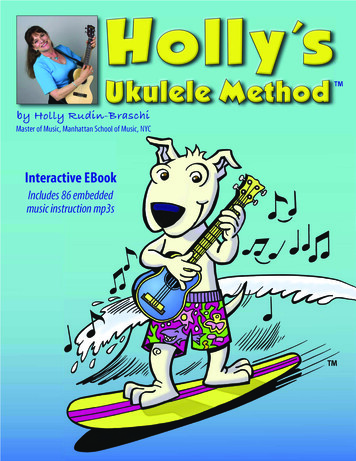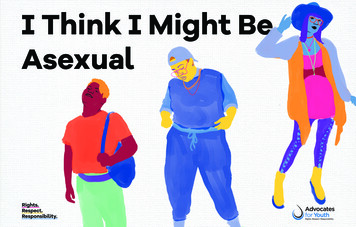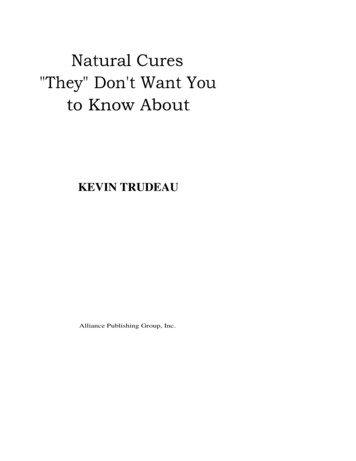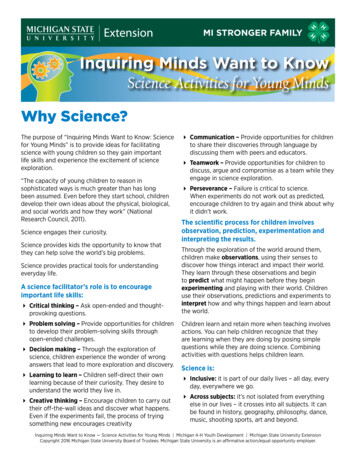
Transcription
MI STRONGER FAMILYInquiring Minds Want to KnowScience Activities for Young MindsWhy Science?The purpose of “Inquiring Minds Want to Know: Sciencefor Young Minds” is to provide ideas for facilitatingscience with young children so they gain importantlife skills and experience the excitement of scienceexploration.“The capacity of young children to reason insophisticated ways is much greater than has longbeen assumed. Even before they start school, childrendevelop their own ideas about the physical, biological,and social worlds and how they work” (NationalResearch Council, 2011).Science engages their curiosity.Science provides kids the opportunity to know thatthey can help solve the world’s big problems.Science provides practical tools for understandingeveryday life.A science facilitator’s role is to encourageimportant life skills: Critical thinking – Ask open-ended and thoughtprovoking questions. Problem solving – Provide opportunities for childrento develop their problem-solving skills throughopen-ended challenges. Decision making – Through the exploration ofscience, children experience the wonder of wronganswers that lead to more exploration and discovery. Learning to learn – Children self-direct their ownlearning because of their curiosity. They desire tounderstand the world they live in. Creative thinking – Encourage children to carry outtheir off-the-wall ideas and discover what happens.Even if the experiments fail, the process of tryingsomething new encourages creativity Communication – Provide opportunities for childrento share their discoveries through language bydiscussing them with peers and educators. Teamwork – Provide opportunities for children todiscuss, argue and compromise as a team while theyengage in science exploration. Perseverance – Failure is critical to science.When experiments do not work out as predicted,encourage children to try again and think about whyit didn’t work.The scientific process for children involvesobservation, prediction, experimentation andinterpreting the results.Through the exploration of the world around them,children make observations, using their senses todiscover how things interact and impact their world.They learn through these observations and beginto predict what might happen before they beginexperimenting and playing with their world. Childrenuse their observations, predictions and experiments tointerpret how and why things happen and learn aboutthe world.Children learn and retain more when teaching involvesactions. You can help children recognize that theyare learning when they are doing by posing simplequestions while they are doing science. Combiningactivities with questions helps children learn.Science is: Inclusive: it is part of our daily lives – all day, everyday, everywhere we go. Across subjects: it’s not isolated from everythingelse in our lives – it crosses into all subjects. It canbe found in history, geography, philosophy, dance,music, shooting sports, art and beyond.Inquiring Minds Want to Know — Science Activities for Young Minds Michigan 4-H Youth Development Michigan State University ExtensionCopyright 2016 Michigan State University Board of Trustees. Michigan State University is an affirmative action/equal opportunity employer.
Developing literacy skills: literacy skills are integralto science – reading, writing and speaking are allessential to comprehending and communicatingissues and ideas. Developing math skills: math is integral to science– sorting and classifying, estimating, counting,measuring, graphing, collecting data and analyzing.Science is not children to have them follow the directions andachieve the predicted results, but that is not whatscience is about. Magic – Science is about trying to understand whythings happen. Science does create cool things thatmystify your classroom. However, if you don’t try todiscover the science behind the magic, you are notdoing science. Knowing the answers – Science is about discovery,not about what you already know. Science is nota set of facts that have already been discoveredby others. It is a process – a way of thinking andunderstanding the world. When you are workingwith young children, they may not get the correctanswer, and that is fine. It is more import toencourage children to ask how and why.Science: Asking Questions, Discovering Answers A recipe – Science isn’t just about following a setof instructions to get the same results each time.When experiments do not work out as predicted,help children to try again and think about why theydidn’t work. It is tempting when working with youngIt’s more important to ask the questions than to givethe answer!“Somewhere, something incredible is waiting to beknown” (Carl Sagan). And somewhere there arechildren who are ready and excited to discover thoseincredible things.“The whole of science is nothing more than arefinement of everyday thinking” (Albert Einstein).Science is all around us. Explore it!MSU is an affirmative-action, equal-opportunity employer, committed to achieving excellence through adiverse workforce and inclusive culture that encourages all people to reach their full potential. MichiganState University Extension programs and materials are open to all without regard to race, color, nationalorigin, gender, gender identity, religion, age, height, weight, disability, political beliefs, sexual orientation, marital status, family status or veteran status. Issued infurtherance of MSU Extension work, acts of May 8 and June 30, 1914, in cooperation with the U.S. Department of Agriculture. Jeffrey W. Dwyer, Director, MSUExtension, East Lansing, MI 48824. This information is for educational purposes only. Reference to commercial products or trade names does not imply endorsementby MSU Extension or bias against those not mentioned. The 4-H Name and Emblem have special protections from Congress, protected by code 18 USC 707. Producedby ANR Creative for MSU Extension. 1P-WEB-09:2016-LJ/MR WCAG 2.0 AA.Inquiring Minds Want to Know — Science Activities for Young Minds Michigan 4-H Youth Development Michigan State University ExtensionCopyright 2016 Michigan State University Board of Trustees. Michigan State University is an affirmative action/equal opportunity employer.
MI STRONGER FAMILYInquiring Minds Want to KnowScience Activities for Young MindsRecommended ReadingYouth can enhance their knowledge about science and the world around them in many ways. Reading for pleasureis one of those ways. It encourages young people to continue to explore their personal interests.The books suggested here are both fiction and nonfiction titles focused on science inquiry. Each book provides anopportunity for children to read and increase their science literacy and offers opportunities to incorporate scienceconcepts into other activities.The books can be used to start discussions on topics currently being explored or simply for personal enjoyment.Either way, they enhance learning.Activity TitleGeneral topicsBean HuntersAnimal and plant adaptationBouncing BubblesStates of matter: mixtures sink and float, things that don’t mixBuild a FarmFarm design and environmentsChromatography ButterfliesStates of matter: mixtures sink and float, things that don’t mixCleaning and Shining PenniesAcid/soapCleaning TeethHuman bodyCreate A CritterAnimal and plant adaptationDancing KernelsStates of matter: mixtures sink and float, things that don’t mixGrowing Plastic BeadsWater, hydration, weather, water cycle, hot and coldIncredible Inflating BalloonAcid/baseLaunching Cotton BallsEnergy of motion/engineering/simple machinesLava LampStates of matter: mixtures sink and float, things that don’t mixMake It RainWater, hydration, weather, water cycle, hot and coldOobleckStates of matter: mixtures sink and float, things that don’t mixRamp and RollEnergy of motion/engineering/simple machinesSoil TubesWater hydration, weather, water cycle, hot and coldProblem solving and science exploration: Wild Ideas by Elin Kelsey, Owlkids Books Inc. One Small Square: Backyard by Donald M. Silver,Learning Triangle Press Usborne First Illustrated Science Dictionary bySarah Khan, EDC Publishing Usborne Illustrated Elementary Science Dictionaryby Sarah Khan and Dr. Lisa Jane Gillespie, EDCPublishing Smithsonian Science: A Visual Encyclopedia, DKPublishingInquiring Minds Want to Know — Science Activities for Young Minds Michigan 4-H Youth Development Michigan State University ExtensionCopyright 2016 Michigan State University Board of Trustees. Michigan State University is an affirmative action/equal opportunity employer.
Animal and plant adaptation: Just Kids: Pictures, Poems and Other Silly AnimalStuff Just for Kids compiled by Bonnie LouiseKuchler, Willow Creek Press In the Forest, by Gillimard-Jeuesse, illustrations byPierre de Hugo, Cartwheel Publishing A Rainbow of Animals by Melissa Stewart, EnslowPublishers, Inc. Rainbow, by Marion Dane Bauer, Simon SpotlightPublishing Unbeatable Beaks by Stephen R. Swinburne,Scholastic, Inc. Green by Laura Vaccaro Seeger, Roaring Book Press Butterfly, Butterfly: A Book of Colors byPetr Horáĉek, Candlewick PressFarm design and environments: The Secret Pool by Kimberly Ridley, Tilbury HousePublishers Old MacDonald by Amy Schwartz, Scholastic, Inc. True or False: Farm Animals by Melvin and GildaBerger, Scholastic, Inc. Trees by Lisa Jane Gillespie, EDC Publishing How Flowers Grow by Emma Helbrough, EDCPublishing The Tiny Seed by Eric Carle, Scholastic, Inc.States of matter: Mixtures, sink and float, thingsthat don’t mix: Pop! A Book about Bubbles by Kimberly BrubakerBradley, Margaret Miller (photographer), HarperCollins Publishing Perimeter, Area, and Volume: A Monster Book ofDimensions by David A. Adler, Holiday House Solids by Jim Mezzanotte, Weekly Reader EarlyLearning Library Liquids by Jim Mezzanotte, Weekly Reader EarlyLearning Library Gravity by Jason Chin, Roaring Brook Press Hot and Cold by Gini Holland, Weekly Reader EarlyLearning Library Blue Chicken by Deborah Freedman, Penguin Group,Inc. Bartholomew and the Oobleck by Dr. Seuss, RandomHouse One Duck Stuck by Phyllis Root, Scholastic, Inc.Energy of motion/engineering/simple machines: Stop that Ball! by Mike McClintock, Random House Drummer Hoff adapted by Barbara Emberley,Prentice-Hall; 5th Printing edition (1967) What Happened? By Rozanne Lanczak Williams,Gwen Connelly (illustrator), Creative Teaching Press Smithsonian Science: A Visual Encyclopedia, DKPublishing A House for Hermit Crab by Eric Carle, Scholastic, Inc. Roll, Slope, and Slide: A Book about Ramps byMichael Dahl, Picture Window Books Forces Make Things Move (Let’s-Read-and-Find-OutScience 2) by Kimberly Brubaker Bradley, Paul Meisel(illustrator), Harper Collins Publishing Motion: Push and Pull, Fast and Slow by DarleneStille, Sheree Boyd (illustrator), Picture WindowBooks (January 1, 2004) The Road Builders by B. G. Hennessy, Simms Taback(illustrator), Puffin PublishersWater hydration, weather, water cycle, hot and cold: Hello Ocean, Hola Mar by Pam Muñoz Ryan,Scholastic, Inc. Little Cloud by Eric Carle, Scholastic, Inc. Raindrops Roll by April Pulley Sayre, Beach LaneBooks Water is Water by Miranda Paul, Roaring Brook Press Hot Dog, Cold Dog by Frann Preston-Gannon, POW!PublishingHuman body: Andrew’s Loose Tooth by Robert Munsch, Scholastic,Inc. My Amazing Body: A First Look at Health and Fitnessby Pat Thomas, Barron’s Educational Series, Inc. Brush, Brush, Brush by Alicia Padron, Children’s PressPublishing Melvin the Magnificent Molar! by Julia Cook & LauraJana, Melvin Publisher Brush Your Teeth, Please by Leslie McGuire, Reader’sDigestMSU is an affirmative-action, equal-opportunity employer, committed to achieving excellence through adiverse workforce and inclusive culture that encourages all people to reach their full potential. MichiganState University Extension programs and materials are open to all without regard to race, color, nationalorigin, gender, gender identity, religion, age, height, weight, disability, political beliefs, sexual orientation, marital status, family status or veteran status. Issued infurtherance of MSU Extension work, acts of May 8 and June 30, 1914, in cooperation with the U.S. Department of Agriculture. Jeffrey W. Dwyer, Director, MSUExtension, East Lansing, MI 48824. This information is for educational purposes only. Reference to commercial products or trade names does not imply endorsementby MSU Extension or bias against those not mentioned. The 4-H Name and Emblem have special protections from Congress, protected by code 18 USC 707. Producedby ANR Creative for MSU Extension. 1P-WEB-09:2016-LJ/MR WCAG 2.0 AA.Inquiring Minds Want to Know — Science Activities for Young Minds Michigan 4-H Youth Development Michigan State University ExtensionCopyright 2016 Michigan State University Board of Trustees. Michigan State University is an affirmative action/equal opportunity employer.
MI STRONGER FAMILYInquiring Minds Want to KnowScience Activities for Young MindsInquiring Minds Want to Know ContactsThe Inquiring Minds Want to Know: Science for Young Minds program was developed as a collaborative effort ofthe Early Childhood Education team and the Science Literacy team.Staff members who have participated in the train-the-trainer training but have questions on any of the materialsor activities are welcome to contact any team member for assistance.Team members are also available to do local trainings if local staff members are not available to do them.Darren BagleyMichigan State University Extension605 N. Saginaw St., Suite 1-A, Flint, MI 48502bagleyda@msu.eduTracy D’AugustinoMichigan State University Extension320 S. State St., Harrisville, MI 48740daugustt@msu.eduJan BrinnMichigan State University Extension3255 122nd Ave., Suite 103, Allegan, MI 49010brinn@msu.eduKendra MoysesMichigan State University Extension446 W. Circle Drive, Rm. 160, East Lansing, MI 48824kmoyses@msu.eduKittie ButcherMichigan State University Extension100 East State Street, St. Johns, MI 48879butche36@msu.eduDorothy MunnMichigan State University Extension205 S. 8th St., West Branch, MI 48661munnd@msu.eduInquiring Minds Want to Know — Science Activities for Young Minds Michigan 4-H Youth Development Michigan State University ExtensionCopyright 2016 Michigan State University Board of Trustees. Michigan State University is an affirmative action/equal opportunity employer.
MI STRONGER FAMILYInquiring Minds Want to KnowScience Activities for Young MindsInquiring Minds Want to KnowResourcesScience is in the world all around us and affectsour everyday lives. Look for experiential learningopportunities in activities involving music, art, cooking,math, outdoor walks and more.4-H resources from other states to supportscience education for children 5-8When planning, think about how you can help childrensee the science involved. You may need to do someresearch ahead of time so that you understand, but itcan be fun for you and your children. Wisconsin Science Activitieswww.uwex.edu/ces/4h/set/science.cfmYour child might not be a future scientist, but you neverknow, so help him or her get off to a good start. 4-H Science Blast in the Class, MSU Extension4h.msue.msu.edu/4h/science blast National 4-H Science Day ay Ohio 4-H Cloverbud Connectionswww.go.osu.edu/click New York 4-H Science Tool T.aspx 4-H Science Discovery Series science-discovery/07914.aspxScience resources to support science educationfor children 5-8 WKAR and PBS Televisionwww.pbskids.org Science Activities, American Chemical ces/k-8/science-activities.htmlMSU is an affirmative-action, equal-opportunity employer, committed to achieving excellence through adiverse workforce and inclusive culture that encourages all people to reach their full potential. MichiganState University Extension programs and materials are open to all without regard to race, color, nationalorigin, gender, gender identity, religion, age, height, weight, disability, political beliefs, sexual orientation, marital status, family status or veteran status. Issued infurtherance of MSU Extension work, acts of May 8 and June 30, 1914, in cooperation with the U.S. Department of Agriculture. Jeffrey W. Dwyer, Director, MSUExtension, East Lansing, MI 48824. This information is for educational purposes only. Reference to commercial products or trade names does not imply endorsementby MSU Extension or bias against those not mentioned. The 4-H Name and Emblem have special protections from Congress, protected by code 18 USC 707. Producedby ANR Creative for MSU Extension. 1P-WEB-11:2016-LJ/MR WCAG 2.0 AA.Inquiring Minds Want to Know — Science Activities for Young Minds Michigan 4-H Youth Development Michigan State University ExtensionCopyright 2016 Michigan State University Board of Trustees. Michigan State University is an affirmative action/equal opportunity employer.
MI STRONGER FAMILYInquiring Minds Want to KnowScience Activities for Young MindsBean HuntersWHAT YOU’LL NEED Plastic utensils (spoon, fork andknife) Three types of dried beans (themore varied the size, shape andcolor, the better). For example:garbanzos, lentils, kidneys, greatnorthern beans, soybeans, splitpeas, black beans, large limabeans, etc. 3-ounce cup for each student Stopwatch timerWHAT TO DORemember: The purpose is NOT to teach a specific topic but to helpchildren experience the excitement of science exploration!GETTING READYTalk to the children about what all animals need to survive. The mostbasic survival needs are water, food, space and shelter. Explain thatthey will be predators – hunters – and need to catch food to survive.NOTE: With very small children, the beans have potential to be achoking hazard.LET’S GO1. Break the children into three groups. Give each group a differenttype of utensil to use. Explain to the children that they will bepredators, animals hunting down their food to survive. You cangive names to the creatures they will be hunting (such as “cyclops”for black-eyed peas or “green goblins” for split peas). Explain tothe children that they need to capture and “eat” (put in their cup,not actually eat) enough food to survive to the next round.Which predators do you predict will get the most food? Whatfood do you think will be captured first?2. Spread the dry beans out on a table or floor (the amount of beanswill vary depending on the size of your group, but provide at least½ cup per child). Set the timer for 1 minute and let the children tryto catch as many beans as they can to fill their cups. After 1 minute,discuss what the children observed.Were your predictions correct? Why did one group do betterthan another? What type of beans got “eaten” more? Why? Doyou think anything will be different if we do it again?3. Students who did not get at least 20 beans (numbers might vary)have to sit out the next round. Remind them that they have animportant job: they should observe those who survived and see ifsome people are more successful predators than others.Inquiring Minds Want to Know — Science Activities for Young Minds Michigan 4-H Youth Development Michigan State University ExtensionCopyright 2016 Michigan State University Board of Trustees. Michigan State University is an affirmative action/equal opportunity employer.
4. After the second round, have the children who were observerstalk about what they observed first, and then have all the childrendiscuss.TALK IT OVERWhich tool worked the best? Why?(For the observers) What did the most successful predator do differently that allowed him to be successful?How do you think this is similar to what happens with wild animals innature?RESOURCES Your local university Extension office– http://msue.anr.msu.edu/county. Science Blast website – science blast. Steve Spangler website – http://www.stevespanglerscience.com/.Did having fewer predators make it easier to capture the beans?GOOD TO KNOWPreschool: After the second round, ask the children to come up with differentrules for the game, then compare how that changes the outcome.Examples: using one arm, wearing blindfolds, using only the nondominant hand or having to catch two beans at once.Upper middle and high school students: Use gloves, tweezers, chopsticks or other utensils. Vary the time spent hunting based on the age of participants.Older kids can hunt for shorter periods of time. Graph the number of prey captured and/or predators that survived. Have students use two utensils (one in each hand). They can be thesame or different.THE SCIENCE BEHIND ITIn nature, all animals require food, water, shelter and space to survive.How well an animal is adapted to its environment affects its abilityto survive. Animals that can quickly adjust to environmental changesaffecting water, space, shelter or food have a higher chance of surviving. The animals that survive are the ones able to react or adapt tonew predators trying to eat them or deal with radical changes to theirhabitat. The animals that are slower to react or adapt may end upon the threatened or endangered lists. A new type of plant or animalmight move into an area, and the existing life needs to change or thenew ones will outcompete them. Invasive species such as emerald ashborer, sea lamprey or garlic mustard are examples of this.MSU is an affirmative-action, equal-opportunity employer,committed to achieving excellence through a diverseworkforce and inclusive culture that encourages all peopleto reach their full potential. Michigan State UniversityExtension programs and materials are open to all withoutregard to race, color, national origin, gender, gender identity,religion, age, height, weight, disability, political beliefs,sexual orientation, marital status, family status or veteranstatus. Issued in furtherance of MSU Extension work, actsof May 8 and June 30, 1914, in cooperation with the U.S.Department of Agriculture. Jeffrey W. Dwyer, Director,MSU Extension, East Lansing, MI 48824. This informationis for educational purposes only. Reference to commercialproducts or trade names does not imply endorsement byMSU Extension or bias against those not mentioned. The 4-HName and Emblem have special protections from Congress,protected by code 18 USC 707. Produced by ANR Creative forMSU Extension. 1P-WEB-11:2016-LJ/MR WCAG 2.0 AA.Inquiring Minds Want to Know — Science Activities for Young Minds Michigan 4-H Youth Development Michigan State University ExtensionCopyright 2016 Michigan State University Board of Trustees. Michigan State University is an affirmative action/equal opportunity employer.
MI STRONGER FAMILYInquiring Minds Want to KnowScience Activities for Young MindsBouncing BubblesWHAT YOU’LL NEED 1 cup of distilled water (or youcan try tap water) 2 tablespoons of Dawn dish soap 1 tablespoon of glycerin Pair of inexpensive gloves or tubesocks to put on your hands Small bubble wand or pipette(plastic eyedropper)WHAT TO DORemember: The purpose is NOT to teach a specific topic but to helpchildren experience the excitement of science exploration!GETTING READYMake up a batch of bubble solution with the ingredients listed to theleft. Making your bubble solution at least 24 hours in advance andallowing it to sit undisturbed will allow the bonds in your bubblesolution to strengthen. You know what that means, right? Strongerbubbles!LET’S GO1. Using a small bubble wand, blow a bubble about the size of abaseball. If you are using the pipette instead of the bubble wand,cut the bulb off the top of the pipette, dip one end into the bubblesolution, and blow into the other end of the pipette.What do you observe? What shape are the bubbles? Whatcolor? Do they reflect images? Can you see yourself in thesurface of a bubble? What do you predict will happen when youtry to touch the bubbles with your gloved hands?2. Have the children blow another bubble and try to gently bounce abubble off of your gloves.What happened?3. Have the children blow another bubble and try bouncing thebubble off of your shirt or pants.Do some fabrics bounce bubbles better than others?4. Blow several bubbles and have the children gently blow or fanthem to keep them from hitting the ground so they pop withoutinterference.Do some bubbles last longer than others? Why? Are theybigger? Smaller?Inquiring Minds Want to Know — Science Activities for Young Minds Michigan 4-H Youth Development Michigan State University ExtensionCopyright 2016 Michigan State University Board of Trustees. Michigan State University is an affirmative action/equal opportunity employer.
TALK IT OVERWhy do you think bubbles are round rather than other shapes?Where do bubbles exist in nature?Why do bubbles move through the air the way they do?Where do bubbles go when they pop?What is inside bubbles?What makes a bubble pop?RESOURCES Your local university Extension office– http://msue.anr.msu.edu/county. Science Blast website – science blast. PBS – ities/preschooler-kindergarten/.GOOD TO KNOW Use two sheets of clear plastic (overhead sheets or pageprotectors). Dip both sheets and the blocks in the bubble solution,then put one sheet on a table and place the second sheet on topwith small blocks between them. Then blow bubbles betweenthem. When bubbles are about the same size as each other(uniform), they form perfect hexagons. Have older students explore why bubbles are round.THE SCIENCE BEHIND ITA bubble is air wrapped in a soapy film. The outside and insidesurfaces of a bubble consist of soap molecules. A thin layer of waterlies between the two layers of soap molecules, sort of like a watersandwich with soap molecules for bread. The bubble pops when itruns into something or the layer of water evaporates. Adding glycerinlengthens the lifespan of bubbles. Glycerin forms weak hydrogenbonds with water, delaying evaporation. Dry air or dry hands can stillburst a bubble.MSU is an affirmative-action, equal-opportunity employer,committed to achieving excellence through a diverseworkforce and inclusive culture that encourages all peopleto reach their full potential. Michigan State UniversityExtension programs and materials are open to all withoutregard to race, color, national origin, gender, gender identity,religion, age, height, weight, disability, political beliefs,sexual orientation, marital status, family status or veteranstatus. Issued in furtherance of MSU Extension work, actsof May 8 and June 30, 1914, in cooperation with the U.S.Department of Agriculture. Jeffrey W. Dwyer, Director,MSU Extension, East Lansing, MI 48824. This informationis for educational purposes only. Reference to commercialproducts or trade names does not imply endorsement byMSU Extension or bias against those not mentioned. The 4-HName and Emblem have special protections from Congress,protected by code 18 USC 707. Produced by ANR Creative forMSU Extension. 1P-WEB-11:2016-LJ/MR WCAG 2.0 AA.Inquiring Minds Want to Know — Science Activities for Young Minds Michigan 4-H Youth Development Michigan State University ExtensionCopyright 2016 Michigan State University Board of Trustees. Michigan State University is an affirmative action/equal opportunity employer.
MI STRONGER FAMILYInquiring Minds Want to KnowScience Activities for Young MindsBuild a FarmWHAT YOU’LL NEED White plastic shower curtain oroversized poster board Assorted colors of permanentmarkers Magazines with photos ofagriculture, farms, etc.WHAT TO DORemember: The purpose is NOT to teach a specific topic but to helpchildren experience the excitement of science exploration!GETTING READYSet out a large white shower curtain or oversized poster board, assorted permanent markers and magazines about agriculture.LET’S GO1. Have children tell you what is on a farm. What makes it run? Whyare these things on the farm? What is their purpose?2. Encourage them to decide what type of farm they will have. Willtheir farm be specialized for vegetables, fruits, crops or livestock?3. Ask the children to imagine what their farm needs to look like. Howmuch land will they need to have? What types of buildings, roads,fences or feed equipment are needed? What is needed to keepanimals safe?4. As the children discuss and plan how they will organize their farm,suggest looking at agricultural magazines or photos to get ideas.Ask children questions to encourage them to think about theplacement of structures and roadways on their farm. Where doesthe water come from? Where does it go after they are done using it(drainage)? When considering where to place roads or driveways,think about where they need to travel. What safety considerationsdo they need to make? Is there a busy street that could bedangerous for animals?5. Ask the children to draw their farm on the white plastic showercurtain or poster board using permanent markers. Encouragethem to include as much detail as possible.Inquiring Minds Want to Know — Science Activities for Young Minds Michigan 4-H Youth Development Michigan State University ExtensionCopyright 2016 Michigan State University Board of Trustees. Michigan State University is an affirmative action/equal opportunity employer.
TALK IT OVERWhy is it important to decide how to lay out a farm?Does it matter what type of farm it is? Why or why not?What has to happen to the animals and plants grown on the farm before they get to the grocery store?What things in a grocery store come from a farm?How does the food made on the farm get to the store?What happens to the poop from the
Inquiring Minds Want to Know Science Activities or Young Minds Michigan -H Youth Development Michigan State University Etension . Unbeatable Beaks by Stephen R. Swinburne, Scholastic, Inc. Green by Laura Vac


